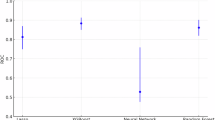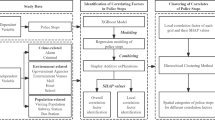Abstract
The rate of fatal shootings by officers is highly variable across American police agencies, yet the reasons for this variability remain unclear. This study uses Bayesian multilevel models to partition the variation in fatal police shooting rates across 2,727 police agencies between 2015 and 2020 into 3 sources of variability: randomness, differences in social context, and outlier agencies that have exceptionally higher or lower rates than is predicted by observed factors. The results indicate that variation in police shooting rates across agencies is far from random and is primarily associated with differences in social contexts, especially differences in crime rates, 911 call rates, officers per capita and the prevalence of guns. However, even after accounting for extensive differences in contexts, several police agencies consistently have lower or higher police shooting rates than predicted.
This is a preview of subscription content, access via your institution
Access options
Access Nature and 54 other Nature Portfolio journals
Get Nature+, our best-value online-access subscription
$32.99 / 30 days
cancel any time
Subscribe to this journal
Receive 12 digital issues and online access to articles
$119.00 per year
only $9.92 per issue
Buy this article
- Purchase on SpringerLink
- Instant access to full article PDF
Prices may be subject to local taxes which are calculated during checkout




Similar content being viewed by others
Data availability
The data to reproduce the findings of this study are publicly available through the Harvard Dataverse repository at https://doi.org/10.7910/DVN/TU0BNU.
Code availability
The code to reproduce the findings of this study is publicly available through the Harvard Dataverse repository at https://doi.org/10.7910/DVN/TU0BNU.
References
Braga, A. A. & Cook, P. J. Policing Gun Violence: Strategic Reforms for Controlling Our Most Pressing Crime Problem (Oxford Univ. Press, 2023).
Sherman, L. W. Reducing fatal police shootings as system crashes: research, theory, and practice. Annu. Rev. Criminol. 1, 421–449 (2018).
Zimring, F. E. When Police Kill (Harvard Univ. Press, 2017).
Klinger, D. A. Organizational accidents and deadly police-involved violence: some thoughts on extending theory, expanding research, and improving police practice. Ann. Am. Acad. Pol. Soc. Sci. 687, 28–48 (2020).
Skolnick, J. H. & Fyfe, J. J. Above the Law: Police and the Excessive Use of Force (Free Press, 1993).
Fryer, R. G. An empirical analysis of racial differences in police use of force. J. Polit. Econ. 127, 1210–1261 (2019).
Legewie, J. & Fagan, J. Group Threat, Police Officer Diversity and the Deadly Use of Police Force Columbia Public Law Research Paper No. 14-512 (Columbia Law School, 2016); https://papers.ssrn.com/abstract=2778692
Nix, J., Campbell, B. A., Byers, E. H. & Alpert, G. P. A bird’s eye view of civilians killed by police in 2015. Criminol. Public Policy 16, 309–340 (2017).
Ross, C. T. A multi-level Bayesian analysis of racial bias in police shootings at the county-level in the United States, 2011–2014. PLoS ONE 10, e0141854 (2015).
Tregle, B., Nix, J. & Alpert, G. P. Disparity does not mean bias: making sense of observed racial disparities in fatal officer-involved shootings with multiple benchmarks. J. Crime. Justice 42, 18–31 (2019).
Brunson, R. K. Protests focus on over-policing. But under-policing is also deadly. Washington Post (2020).
Donner, C. M., Maskaly, J., Piquero, A. R. & Jennings, W. G. Quick on the draw: assessing the relationship between low self-control and officer-involved police shootings. Police Q. 20, 213–234 (2017).
Fyfe, J. J. Observations on police deadly force. Crime. Delinq. 27, 376–389 (1981).
Geller, W. A. & Karales, K. J. Split Second Decisions: Shootings of & by Chicago Police: A Report of the Chicago Law Enforcement Study Group (CLESG, 1981).
Ridgeway, G. The role of individual officer characteristics in police shootings. Ann. Am. Acad. Pol. Soc. Sci. 687, 58–66 (2020).
Zhao, L. & Papachristos, A. V. Network position and police who shoot. Ann. Am. Acad. Pol. Soc. Sci. 687, 89–112 (2020).
Hemenway, D., Azrael, D., Conner, A. & Miller, M. Variation in rates of fatal police shootings across US states: the role of firearm availability. J. Urban Health 96, 63–73 (2019).
Nagin, D. S. Firearm availability and fatal police shootings. Ann. Am. Acad. Pol. Soc. Sci. 687, 49–57 (2020).
Sheppard, K. G., Zimmerman, G. M. & Fridel, E. E. Examining the relevance of contextual gun ownership on fatal police shootings. Justice Q. 39, 1214–1236 (2022).
Zimring, F. E. The City that Became Safe: New York’s Lessons for Urban Crime and Its Control (Oxford Univ. Press, 2011).
Jennings, J. T. & Rubado, M. E. Preventing the use of deadly force: the relationship between police agency policies and rates of officer-involved gun deaths. Public Adm. Rev. 77, 217–226 (2017).
Miller, J. & Chillar, V. F. Do police body-worn cameras reduce citizen fatalities? Results of a country-wide natural experiment. J. Quant. Criminol. 38, 723–754 (2022).
O’Guinn, B. J. Police training and accountability: a remedy or an impediment for reducing unarmed police shootings? Crime Delinq. https://doi.org/10.1177/00111287221074959 (2022).
Shjarback, J. A., White, M. D. & Bishopp, S. A. Can police shootings be reduced by requiring officers to document when they point firearms at citizens? Inj. Prev. 27, 508–513 (2021).
Sparger, J. R. & Giacopassi, D. J. Memphis revisited: a reexamination of police shootings after the Garner decision. Justice Q. 9, 211–225 (1992).
Montiel Olea, J. L., O’Flaherty, B. & Sethi, R. Empirical Bayes Counterfactuals in Poisson Regression with an Application to Police Use of Deadly Force (SSRN, 2021); https://doi.org/10.2139/ssrn.3857213
Gelman, A. et al. Bayesian Data Analysis 3rd edn (CRC Press, 2013).
Vehtari, A., Gelman, A. & Gabry, J. Practical Bayesian model evaluation using leave-one-out cross-validation and WAIC. Stat. Comput. 27, 1413–1432 (2017).
Nix, J. On the challenges associated with the study of police use of deadly force in the United States: a response to Schwartz & Jahn. PLoS ONE 15, e0236158 (2020).
Arnio, A. N. Examining the effects of neighborhood contextual factors on officer-involved shootings. Justice Q. 38, 626–652 (2021).
Fyfe, J. J. Geographic correlates of police shooting: a microanalysis. J. Res. Crime. Delinq. 17, 101–113 (1980).
Klinger, D. A., Rosenfeld, R., Isom, D. & Deckard, M. Race, crime, and the micro-ecology of deadly force. Criminol. Public Policy 15, 193–222 (2016).
Klinger, D. A. Environment and organization: reviving a perspective on the police. Ann. Am. Acad. Pol. Soc. Sci. 593, 119–136 (2004).
Reiss, A. & Bordua, D. J. in The Police: Six Sociological Essays (ed. Bordua, D. J.) 25–55 (Wiley, 1967).
Sherman, L. W., Cohn, E. G., Gartin P. R., Hamilton E. E. & Rogan D. P. Citizens Killed by Big City Police, 1970–84 (Crime Control Institute, 1986).
O’Flaherty, B. & Sethi, R. in Handbook on Economics of Discrimination and Affirmative Action (ed. Deshpande, A.) 1–25 (Springer Nature, 2023).
Edwards, F., Lee, H. & Esposito, M. Risk of being killed by police use of force in the United States by age, race–ethnicity, and sex. Proc. Natl Acad. Sci. USA 116, 16793–16798 (2019).
Bureau of Justice Statistics. Law Enforcement Management and Administrative Statistics (LEMAS) (US Department of Justice); https://bjs.ojp.gov/data-collection/law-enforcement-management-and-administrative-statistics-lemas
Police Shootings Database 2015–2024: Search by Race, Age, Department (Washington Post); https://www.washingtonpost.com/graphics/investigations/police-shootings-database/
Federal Bureau of Investigation. Crime/Law Enforcement Stats (UCR Program); https://www.fbi.gov/how-we-can-help-you/more-fbi-services-and-information/ucr
US Census Bureau. American Community Survey (ACS); https://www.census.gov/programs-surveys/acs
Azrael, D., Cook, P. J. & Miller, M. State and local prevalence of firearms ownership measurement, structure, and trends. J. Quant. Criminol. 20, 43–62 (2004).
Centers for Disease Control and Prevention. CDC WONDER; https://wonder.cdc.gov/
Acknowledgements
The authors received no specific funding for this work.
Author information
Authors and Affiliations
Contributions
R.N. designed research, analysed data and wrote the article. J.M.M. designed research and wrote the article. A.A.B. wrote the article.
Corresponding author
Ethics declarations
Competing interests
R.N. is employed at RAND, which did not have a role in this research. The other authors declare no competing interests.
Peer review
Peer review information
Nature Human Behaviour thanks Ashley Arnio, Rajiv Sethi and the other, anonymous, reviewer(s) for their contribution to the peer review of this work. Peer reviewer reports are available.
Additional information
Publisher’s note Springer Nature remains neutral with regard to jurisdictional claims in published maps and institutional affiliations.
Supplementary information
Supplementary Information
Supplementary Notes A–G, Figs. 1–16 and Tables 1–9.
Rights and permissions
Springer Nature or its licensor (e.g. a society or other partner) holds exclusive rights to this article under a publishing agreement with the author(s) or other rightsholder(s); author self-archiving of the accepted manuscript version of this article is solely governed by the terms of such publishing agreement and applicable law.
About this article
Cite this article
Neil, R., MacDonald, J.M. & Braga, A.A. Sources of organizational variability in fatal police shootings in the USA. Nat Hum Behav 9, 1113–1121 (2025). https://doi.org/10.1038/s41562-025-02169-7
Received:
Accepted:
Published:
Issue date:
DOI: https://doi.org/10.1038/s41562-025-02169-7



